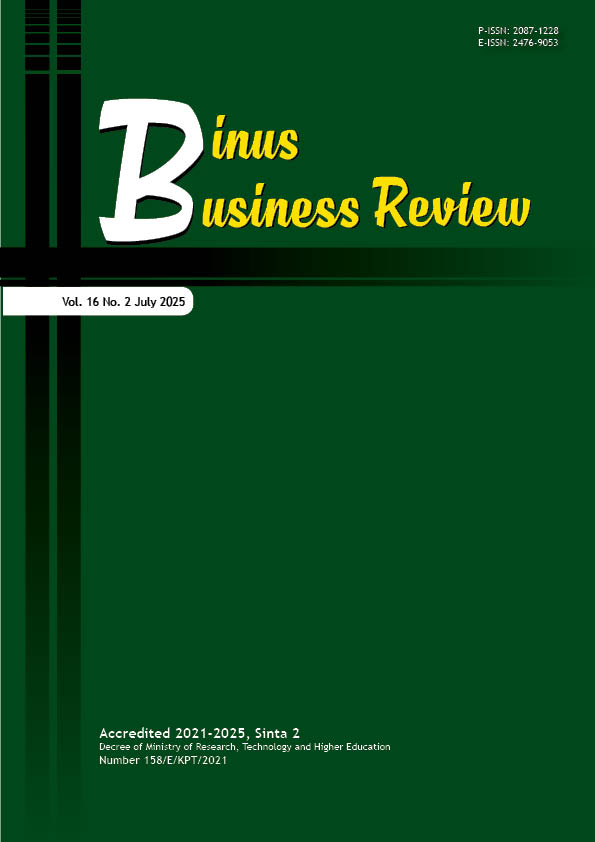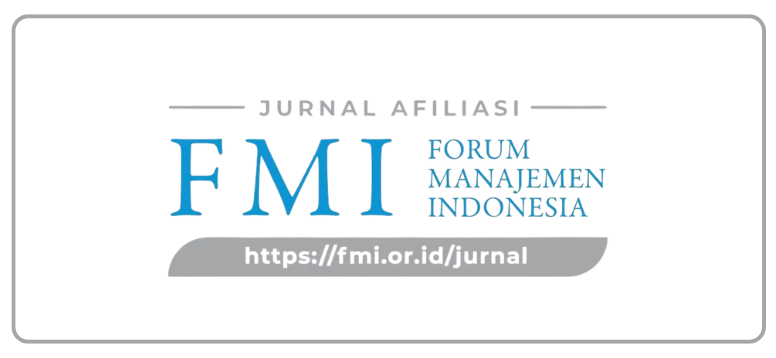Employee Turnover Intention in Indonesian Organizations: The Role of Job Satisfaction (A System Dynamics and Latent Dirichlet Allocation (LDA) Study)
DOI:
https://doi.org/10.21512/bbr.v16i2.12972Keywords:
turnover intentions, job satisfaction, system dynamics, Latent Dirichlet Allocation (LDA)Abstract
The research investigated employee turnover intention, a critical challenge for organizations, especially in Indonesia. The researchers focused on T and U Organizations, exploring the mediating role of job satisfaction. The descriptive data were gathered from ten informants, adopting a qualitative approach. Latent Dirichlet Allocation (LDA) was used to identify keywords from interviews, integrating these insights into a system dynamics model to simulate policies for improving employee retention. This unique NLP-driven integration offered a novel contribution. System dynamics methodology was extensively utilized to unravel complex, dynamic, and interdependent relationships within the system, offering a powerful approach to understanding intricate dynamics. Model simulations reveal a significant relationship. Increased job satisfaction effectively stabilizes turnover intentions. Key factors influencing job satisfaction include work environment, compensation, and job stress. Qualitative analysis also uncovers emergent factors, such as gender inequality in compensation and leader character, as crucial determinants. The research provides a valuable framework for understanding the intricate interplay between turnover intention and job satisfaction by offering practical insights for organizations and guiding future academic endeavors in the dynamic field of human resource management. The research also offers a robust and valuable tool for decision-makers to evaluate targeted policies aimed at enhancing job satisfaction and reducing turnover.
References
Abdolmaleki, G., Naismith, N., Ghodrati, N., Poshdar, M., & Babaeian Jelodar, M. (2024). An analysis of the literature on construction employee turnover: Drivers, consequences, and future direction. Construction Management and Economics, 42(9), 822–846. https://doi.org/10.1080/01446193.2024.2337084
Alefari, M., Almanei, M., & Salonitis, K. (2020). A system dynamics model of employees’ performance. Sustainability, 12(16), 1–30. https://doi.org/10.3390/su12166511
Alias, N. E., Rohmanan, N. H., Ismail, S., Koe, W. L., & Othman, R. (2018). Factors influencing turnover intention in a Malaysian manufacturing company. KnE Social Sciences, 3(10), 771–787. https://doi.org/10.18502/kss.v3i10.3171
Andersen, D. F., Rich, E., & Macdonald, R. (2020). System dynamics applications to public policy. In B. Dangerfield (Ed.), System dynamics: Theory and applications (pp. 253–271). Springer. https://doi.org/10.1007/978-1-4939-8790-0_421
Angraini, A., Efendy, B. S., Munawarah, D., Nurqoriah, H., Laoli, I. S., & Syamsir. (2022). Peranan pemimpin dalam peningkatan kepuasan kerja di Kecamatan Mandiangin Koto Selayan Kota Bukittinggi. Ranah Research: Journal of Multidisciplinary Research and Development, 5(1), 16–22. https://doi.org/10.38035/rrj.v5i1.574
Aruldoss, A., Berube Kowalski, K., Travis, M. L., & Parayitam, S. (2022). The relationship between work–life balance and job satisfaction: Moderating role of training and development and work environment. Journal of Advances in Management Research, 19(2), 240–271. https://doi.org/10.1108/JAMR-01-2021-0002
Ashraf, M. A. (2020). Demographic factors, compensation, job satisfaction and organizational commitment in private university: An analysis using SEM. Journal of Global Responsibility, 11(4), 407–436. https://doi.org/10.1108/JGR-01-2020-0010
Asih, R. P. W. (2021). Pengaruh karakteristik individu dan kompensasi terhadap turnover intention. Jurnal Riset Manajemen dan Bisnis, 1(1), 25–35. https://doi.org/10.29313/jrmb.v1i1.37
Atkinson, J. A., Page, A., Prodan, A., McDonnell, G., & Osgood, N. (2018). Systems modelling tools to support policy and planning. The Lancet, 391(10126), 1158–1159. https://doi.org/10.1016/S0140-6736(18)30302-7
Azmy, A., & Sigalingging, H. (2025). Predictors of Employee performance at electronic manufacturing company: Job satisfaction as mediation. Binus Business Review, 16(1), 39–56. https://doi.org/10.21512/bbr.v16i1.11954
Bai, F., Shang, M., & Huang, Y. (2024). Corporate culture and ESG performance: Empirical evidence from China. Journal of Cleaner Production, 437. https://doi.org/10.1016/j.jclepro.2024.140732
Bala, B. K., Arshad, F. M., & Noh, K. M. (2017). System dynamics: Modelling and simulation. Springer. https://doi.org/10.1007/978-981-10-2045-2
Bangun, W. (2018). Manajemen sumber daya manusia. Erlangga.
Bayo-Moriones, A., Galdon-Sanchez, J. E., & Martinez-de-Morentin, S. (2021). Business strategy, performance appraisal and organizational results. Personnel Review, 50(2), 515–534. https://doi.org/10.1108/PR-09-2019-0498
Berenjkar, P., Li, Y. Y., & Yuan, Q. (2021). The application of system dynamics in different practices of a waste management system. Environment, Development and Sustainability, 23, 15695–15724. https://doi.org/10.1007/s10668-021-01362-8
Blomme, R. J., Van Rheede, A., & Tromp, D. M. (2010). Work-family conflict as a cause for turnover intentions in the hospitality industry. Tourism and Hospitality Research, 10(4), 269–285. https://doi.org/10.1057/thr.2010.15
Bruckmüller, S., & Braun, M. (2020). One group’s advantage or another group’s disadvantage? How comparative framing shapes explanations of, and reactions to, workplace gender inequality. Journal of Language and Social Psychology, 39(4), 457–475. https://doi.org/10.1177/0261927X20932631
Budhiraja, S., & Rathi, N. (2023). Continuous learning during crises: achieving change-efficacy, meaningful work and adaptive performance. International Journal of Productivity and Performance Management, 72(8), 2317–2334. https://doi.org/10.1108/IJPPM-09-2021-0551
Bunker, N. (2021, November 12). September 2021 JOLTS report: Job openings decline, but quits rise. Hiring Lab. https://www.hiringlab.org/2021/11/12/september-2021-jolts-report/
Catalyst. (n.d.). The facts about gender representation. https://www.catalyst.org/research/women-in-management/
Dahiya, R., & Raghuvanshi, J. (2022). Measure human capital because people really matter: Development and validation of human capital scale (HuCapS). International Journal of Productivity and Performance Management, 71(6), 2235–2261. https://doi.org/10.1108/IJPPM-11-2020-0594
Deloitte. (2023). 2023 Gen Z and millennial survey. https://www2.deloitte.com/content/dam/Deloitte/global/Documents/deloitte-2023-genz-millennial-survey.pdf
Falahat, M., Kit, G. S., & Min, L. C. (2019). A model for turnover intention: Banking industry in Malaysia. Asian Academy of Management Journal, 24(Supp. 2), 79–91. https://doi.org/10.21315/aamj2019.24.s2.6
Felmingham, T., Backholer, K., Hoban, E., Brown, A. D., Nagorcka-Smith, P., & Allender, S. (2023). Success of community-based system dynamics in prevention interventions: A systematic review of the literature. Frontiers in Public Health, 11, 1–29. https://doi.org/10.3389/fpubh.2023.1103834
Hariandja, M. T. E. (2002). Manajemen Sumber Daya Manusia. PT Grasindo.
Herawati, N., & Ranteallo, A. T. (2020). Pengaruh gaya kepemimpinan terhadap kepuasan kerja karyawan PT JMS Jakarta. Jurnal Ekonomi, Sosial & Humaniora, 1(10), 1–14.
Hidayatno, A., Destyanto, A. R., Moeis, A. O., & Iman, M. R. N. (2017). Scenario planning using system dynamics for reducing uncertainty on managing employee turnover. In 2nd Asia-Pacific Region System Dynamics Conference.
Kalia, P., Singla, M., & Kaushal, R. (2024). Human resource management practices and employee retention in the Indian textile industry. International Journal of Productivity and Performance Management, 73(11), 96–121. https://doi.org/10.1108/IJPPM-01-2022-0057
Kim, H. S., & Jang, S. C. (2020). The effect of increasing employee compensation on firm performance: Evidence from the restaurant industry. International Journal of Hospitality Management, 88. https://doi.org/10.1016/j.ijhm.2020.102513
Laraswani, R., & Lubis, R. K. (2020). The effect of compensation and working environment on turnover intention in PT. Putra Dolok Mandiri. Journal of Management Science (JMAS), 3(3), 86–90.
Laucereno, S. F. (2021, November 13). Digaji murah, jutaan orang ramai-ramai resign dari tempat kerja. detikfinance. https://finance.detik.com/berita-ekonomi-bisnis/d-5810134/digaji-murah-jutaan-orang-ramai-ramai-resign-dari-tempat-kerja
Lee, Y. J., & Sabharwal, M. (2016). Education–job match, salary, and job satisfaction across the public, non-profit, and for-profit sectors: Survey of recent college graduates. Public Management Review, 18(1), 40–64. https://doi.org/10.1080/14719037.2014.957342
Li, Y., Sawhney, R., & Tortorella, G. L. (2021). Empirical analysis of factors impacting turnover intention among manufacturing workers. International Journal of Business and Management, 14(4), 1–18.
Lin, H., Chen, L., Yu, M., Li, C., Lampel, J., & Jiang, W. (2021). Too little or too much of good things? The horizontal S-curve hypothesis of green business strategy on firm performance. Technological Forecasting and Social Change, 172. https://doi.org/10.1016/j.techfore.2021.121051
Martínez-Valderrama, J., & Ibáñez, J. (2023). Implementing climate change projections in system dynamics models. MethodsX, 10, 1–8. https://doi.org/10.1016/j.mex.2023.102044
Medina, E. (2012). Job satisfaction and employee turnover intention: What does organizational culture have to do with it? [Master's thesis, Columbia University]. https://doi.org/10.7916/D8DV1S08
Memon, N. Z., & Satpathy, B. (2020). Exploring theories of workplace gender inequality and its outcomes: A systematic literature review. Turkish Online Journal of Qualitative Inquiry, 11(3), 727–743.
Nestor-Harper, M. (n.d.). Understaffing issues in the workplace. CHRON. https://smallbusiness.chron.com/understaffing-issues-workplace-46884.html
Nurrahman, A. (2022, June 14). Nah lho! Milenial dan Gen Z ramai-ramai resign karena tempat kerja toxic. detikfinance. https://finance.detik.com/berita-ekonomi-bisnis/d-6126304/nah-lho-milenial-dan-gen-z-ramai-ramai-resign-karena-tempat-kerja-toxic
Ongkowijoyo, Y. S. P. (2021). Strategi manajemen sumber daya manusia dalam mengelola kepemimpinan millenial untuk meningkatkan produktivitas karyawan yang didukung oleh teknologi modern. Jurnal Indonesia Sosial Teknologi, 2(6), 1023–1039.
Rahman, H. M. (2019). Human resource management practices and turnover intention in Bangladesh-A literature review. International Journal of Progressive Sciences and Technologies, 17(1), 233–239.
Rajput, N., Das, G., Shivam, K., Nayak, C. K., Gaurav, K., & Nagpal, P. (2023). An inclusive systematic investigation of human resource management practice in harnessing human capital. Materials Today: Proceedings, 80, 3686–3690. https://doi.org/10.1016/j.matpr.2021.07.362
Riches, O. (2022, April). A great opportunity in Indonesia. Michael Page Indonesia. https://www.michaelpage.co.id/advice/market-insights/market-updates/great-opportunity-indonesia
Satyani, F., Novalensiago, M., Mariki, R., Anti, M. D., Pangestu, T. B., Mandala, D. R., ... & Maldini, D. (2021). Business dynamics model revitalization. Journal of Sustainable Business Hub, 2(2), 53–60.
Schoenenberger, L., Schmid, A., Tanase, R., Beck, M., & Schwaninger, M. (2021). Structural analysis of system dynamics models. Simulation Modelling Practice and Theory, 110, 1–20. https://doi.org/10.1016/j.simpat.2021.102333
Sterman, J. D. (2000). Business dynamics: Systems thinking and modeling for a complex world. McGraw-Hill Higher Education.
Sundiman, D. (2021, August 23). Why business dynamics? [Video]. Youtube. https://www.youtube.com/watch?app=desktop&v=YYL3EOI0R70
Susanto, G. A., Sudjadi, A., & Pinasti, M. (2019). Pengaruh sifat gelap pemimpin terhadap niat keluar kerja karyawan. Performance: Jurnal Personalia, Financial, Operasional, Marketing dan Sistem Informasi, 26(2), 115–127.
Taheri, F. (2021). Family-supportive organizational environment and turnover intention. International Journal of Productivity and Performance Management, 70(8), 2113–2130. https://doi.org/10.1108/IJPPM-10-2019-0467
Taheri, R. H., Miah, M. S., & Kamaruzzaman, M. (2020). Impact of working environment on job satisfaction. European Journal of Business and Management Research, 5(6), 1–5. https://doi.org/10.24018/ejbmr.2020.5.6.643
Tandung, J. C. (2016). The link between HR attributions and employees’ turnover intentions. Gadjah Mada International Journal of Business, 18(1), 55–69. https://doi.org/10.22146/gamaijb.9287
Tarurhor, E., & Olatunji, E. (2022). Business dynamics and manufacturing firms performance in Delta State, Nigeria. Management and Human Resource Research Journal, 11(3), 1–11.
Ulva, M. (2022, February 22). The Great Resignation, gelombang pengunduran diri yang dipicu kelelahan bekerja. Dewi Magazine. http://www.dewimagazine.com/news-art/the-great-resignation-gelombang-pengunduran-diri-yang-dipicu-kelelahan-bekerja
Zimmerman, R. D., & Darnold, T. C. (2009). The impact of job performance on employee turnover intentions and the voluntary turnover process: A meta‐analysis and path model. Personnel Review, 38(2), 142–158. https://doi.org/10.1108/00483480910931316
Downloads
Published
How to Cite
Issue
Section
License
Copyright (c) 2025 Michelle Meily William, Didi Sundiman

This work is licensed under a Creative Commons Attribution-ShareAlike 4.0 International License.
Authors who publish with this journal agree to the following terms:
a. Authors retain copyright and grant the journal right of first publication with the work simultaneously licensed under a Creative Commons Attribution License - Share Alike that allows others to share the work with an acknowledgment of the work's authorship and initial publication in this journal.
b. Authors are able to enter into separate, additional contractual arrangements for the non-exclusive distribution of the journal's published version of the work (e.g., post it to an institutional repository or publish it in a book), with an acknowledgment of its initial publication in this journal.
c. Authors are permitted and encouraged to post their work online (e.g., in institutional repositories or on their website) prior to and during the submission process, as it can lead to productive exchanges, as well as earlier and greater citation of published work.
USER RIGHTS
All articles published Open Access will be immediately and permanently free for everyone to read and download. We are continuously working with our author communities to select the best choice of license options, currently being defined for this journal as follows: Creative Commons Attribution-Share Alike (CC BY-SA)





















